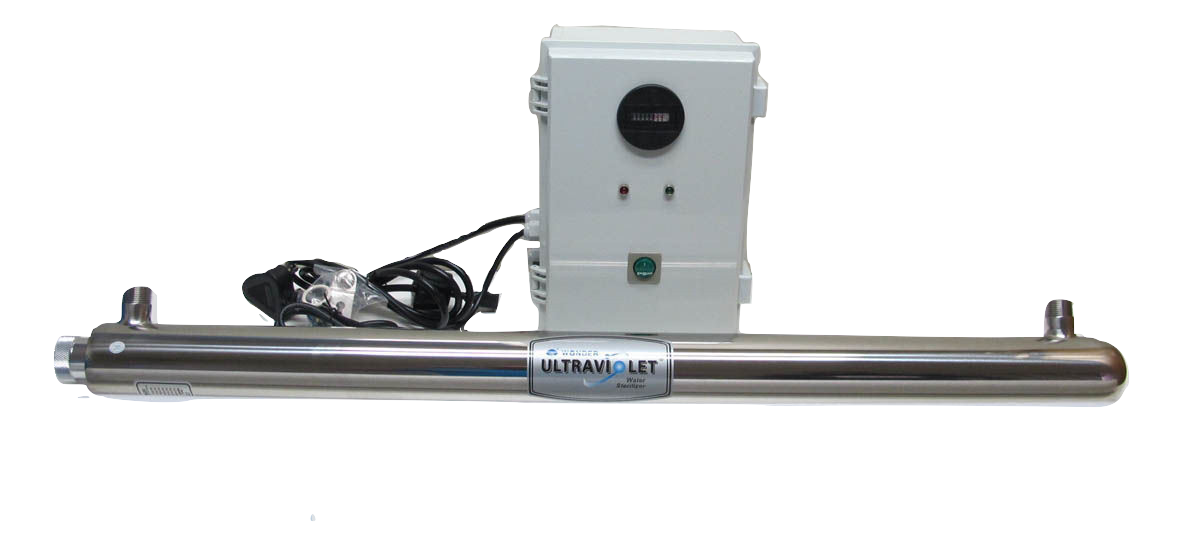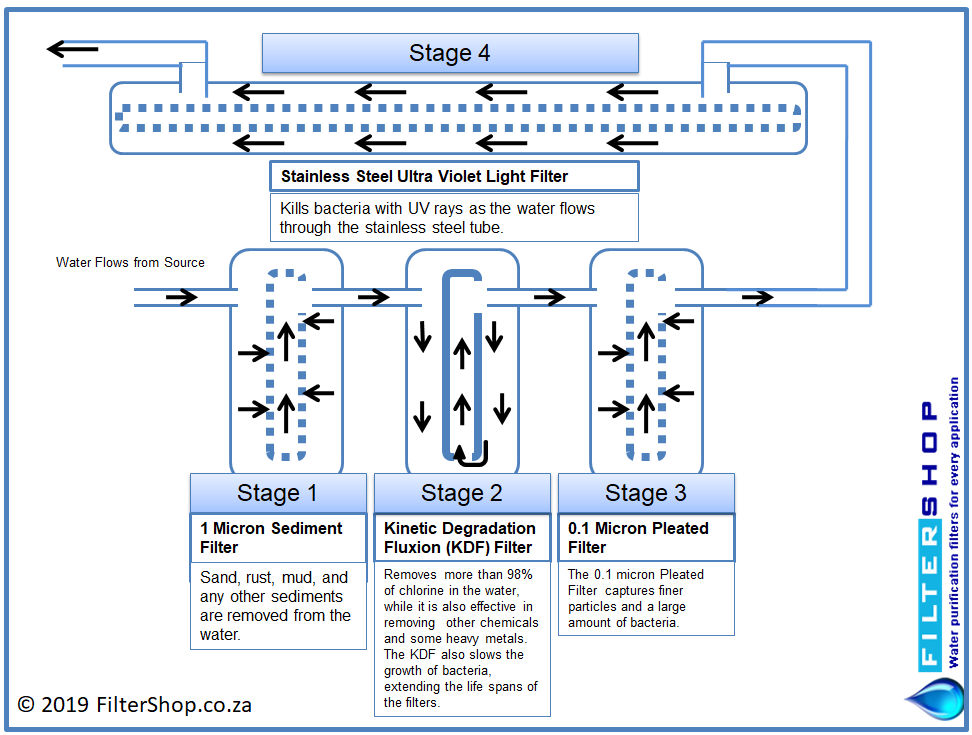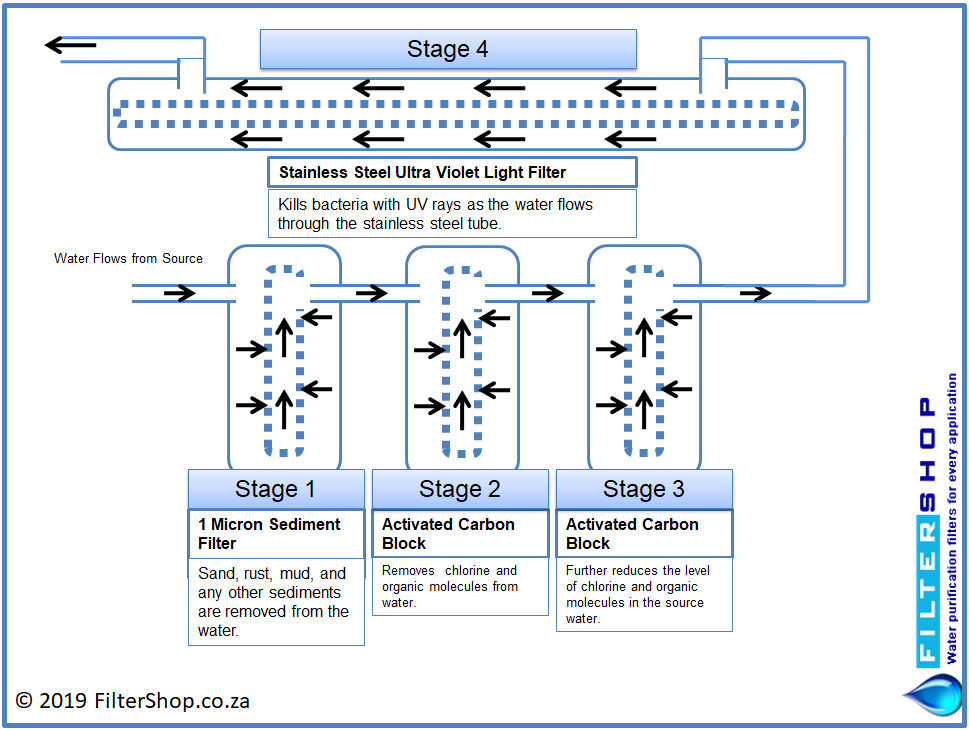1000LPH Premium Industrial Reverse Osmosis System
The Premium Industrial Reverse Osmosis (RO) System is designed for 1000ts/hr for low TDS feed water design Feed TDS <1500ppm.

Applications:
- Drinking water
- Food & Beverage
- Electroplating
- Boiler Feed Water
- Domestic use
- Petrochemical industry
- Process Water
- Wastewater reuse
- Agriculture
- Pretreatment of EDI or Mixed Bed
Benefits
- Fully Equipped & Customizable
- Individually Tested and preserved
- Expandable & Skid Mounted
- Low Operation & Maintenance Costs
- Components Easily Accessible
- Easy Maintenance & Servicing
- Pre-Plumbed Wired & Assembled
Standard Features
- Housing: 20” Big Blue
- Sediment Filter 5 Micron
- Relay & timer control
- Timer Adjustable
- Tank level control
- High-pressure protection
- AutoFlush
- Pretreatment Lockout control backup
- Membrane model: TW30-4040
- Membrane manufacturer: Filmtec
- Membrane rejection: 99.0-99.6%
- Housing Spec: FRP, 300psi, End port
- Feed Solenoid Valve: SS304; 10bar
- Flush Solenoid Valve: SS304; 15bar
High-Pressure Pump
- Type: Vertical Multi-stage Centrifugal
- Pump Material: SS304
- Connection: DIN Flange
- Pump Brand: CNP
Material of Construction
- High - pressure piping: UPVC
- Low - pressure piping: UPVC
- Frame: SS304
- Control box: IP54 ( painted carbon steel)
Instrumentation
- Flow meters: Permeate, concentrate, concentrate recycle
- Conductivity: Permeate
- Pressure gauge: Pre-filter, post- filter, pump discharge, concentrate
- Pressure switch: Feed, RO membrane inlet
Operating Limits / Parameters

Things to Keep In Mind about RO Systems
RO Plant flow ratings
- The production rating of all the RO plants is based on an ideal quality source water, so in situations, with low to poor quality source water the actual flow rate produced by an RO plant can be as low as 30 to 70 % of the rated maximum capacity. So, in other words, a 100 Litre Per Hour plant typically will produce between 30 to 80 liters per hours in real-world applications.
- Please also note that during flushing procedures the RO plant will require 3 times the rated output of the RO from the source. (For example, a 100 liter per RO plant will require a minimum flow rate of 300 Litres per hour from the source).
- Keep in mind that none of the RO plants are designed to be or should be run 24 hours a day, as this will lead to damage of both the components and membranes.
- The RO plants require a minimum of 2 – 3 bar pressure from the source water, if you are using gravity feed then you should consider putting a pressure pump In to feed the RO system.
Waste Water
- As the RO process filters water to such a fine level, the membranes need to flush themselves as they run to remove the contaminants and minerals caught on them. This flushing results in wastewater, which will go straight down the drain.
- On the smaller size industrial RO plants, the wastewater to product water ratio is typically between 1:1 and 2:1. So for every 1 Litre produced by the reverse Osmosis plant between 1 to 2 liters will be used to flush the membranes and goes down the drain.
- With the large-scale RO plants, the wastewater to product water is typically between 1:2 and 1:1. So for every 1 liter of product water produced by the plant between .5 to 1 liter of water is used to flush the membranes and goes down the drain.
- Please keep in mind that the exact wastewater to product water ratio will depend on several factors such as the quality of the source water and what quality of product water you are trying to produce. Normally the lower the TDS you are trying to produce from the RO plant, the high the wastewater ratio will be.
- The RO Plant requires a minimum of 2 bar incoming water pressure.
Product water quality
Typically with most municipal supplies, the Industrial RO plants should produce product water with a TDS of less 10. However, please note that this will depend on the quality and TDS of the source water. Higher source water TDS will lead to a much higher TDS level in the final product water.
Pre-filter Set Options
There are several different Pre-filters available for the Industrial Reverse Osmosis (RO) Systems. Please see below some information on the different options and what each of the filters removes from the water.
2" (50mm) Arkal Disc Filter (20 Micron)

The disc filter will remove any large sediment, dirt, rust, sand and other large visible particles in the water.
The Disc filter will help to remove the larger and coarser sediment, helping to extend the life span of the finer particle filters and RO membrane.
The disc filter can handle a high flow rate.
The disc filter’s cartridge is reusable, and once it becomes filled you simply open the housing, remove the cartridge, wash it under a tap and then replace it in the housing.
Please find more information on the Arkal Disc FIlters at the following link, https://filtershop.co.za/en/disc-filters
100 Litre Crystal Sand Sediment Filter (100 Micron)

Crystal Sands Media is a glass-based filtration media used for removing sediment, dirt, rust, and other large particles.
The Crystal Sands works very much like standard silica sand, filtering sediment out of the water. However, unlike silica sand which should be replaced every 3 to 5 years, Crystal Sand Filter Media can last up to 10 years.
The smoother surface of the Crystal Sands also means that it is harder for bacteria to grow, which helps to extend the life span of the media.
Please find more information on the Crystal Sand Filter Vessel at the following Link, https://filtershop.co.za/en/crystal-sand-filter-vessels-click-for-info
100 Litre AFM Glass Media Vessel (5 - 10 Micron)

AFM® (Glass) Media is also a glass-based filtration media used to remove sediment, dirt, and sand, much like the crystal sand media. However, unlike crystal sand, the AFM® filters down to between 5 & 10 microns, and so removes much finer sediment than the crystal sand. Also unlike the crystal sand media, the AFM® is activated which means it will also remove some chlorine as well as some iron from the source water.
AFM® Activated Filter Media is a direct replacement for sand, doubling the performance of sand filters without the need for additional investments in infrastructure. AFM® resists biofouling, bio coagulation and transient wormhole channeling of unfiltered water and never needs to be recharged or replaced.
AFM® is a highly engineered product manufactured from a specific glass type, processed to obtain the optimum particle size and shape. It is then exposed to a 3-step activation process to increase its surface area by up to 300 times for superior mechanical and electro-static filtration performance.
Please find more information on the AFM® Filter Media at the following link, https://filtershop.co.za/en/afm-glass-media-filter-vessels.
100 Litre Water Softener

The Water softener is used to remove hardness (also known as calcium, lime, kalk) from the water. Hardness (kalk/lime) is very harsh on both the Reverse Osmosis membrane as well as the components of the RO systems itself, so by removing the hardness the water softener helps to preserve the components and extend the life span of the RO membranes.
How does the water Softener Work?
A water softener is an ion exchange system, which essentially means that it swaps one ion for another.
In the case of water softener, it exchanges the hardness ions (calcium & magnesium) for sodium ions.
The cation resin inside of the vessel is coated in sodium ions, as the water flows through the vessel the sodium ions exchange places with the hardness. So the hardness “sticks” to the cation resin inside of the vessel and the sodium ions continue on with the water.
Please find more information on the Water Softener at the following link, https://filtershop.co.za/en/water-softeners
Stainless Steel Ultra Violet (UV) Light

The UV lights kill bacteria and other organisms in the water, using Ultra Violet (UV) rays. While the Reverse Osmosis (RO) Membrane/s will also remove bacteria, in situations with very high bacteria levels, the membrane cannot flush sufficient amounts of bacteria off of its surface. This causes "Bio-Fouling" where the high level of bacteria actually starts to "eat" through the membrane's material reducing its life span. The UV light will help to reduce the number of bacteria that the membrane has to remove, and so help to prevent Bio-fouling from occurring.
There are two sizes of Stainless Steel UV Light available, please see the following links for more information:
High Flow Big Blue System Options
Due to the high flow rate requirements of the large industrial Reverse Osmosis means that a standard big blue system would not be able to cope, so instead, we recommend a dual high flow big blue system. The Dual big blue system uses industry-standard 20" (inch) Big Filter Cartridges, making the replacement filters easy to source and change.

The High Flow Big Blue System is available with several different combinations of Filter Cartridges all of which will pre-form different function and purposes. Please see below more information on the different combinations available.
Filter Set Option 1: 5 Micron, Activated Carbon Block, & 1 Micron

Replacement Filter Costs (Life Span 3 to 6 Months*)
2 x 20" Big Melted Spray (5 Micron) :- R 249.00 each (Total: R 498.00) (Incl. VAT)
2 x 20" Big Activated Carbon Block :- R 325.00 each (Total: R 650.00) (Incl. VAT)
2 x 20" Big Melted Spray (1 Micron) :- R 249.00 each (Total: R 498.00) (Incl. VAT)
Total : R 1 646.00
Filter Set Option 2: 5 Micron, Premium KDF Cartridge, & 1 Micron

Replacement Filter Costs (Life Span 3 to 12 Months*)
2 x 20" Big Melted Spray (5 Micron) :- R 249.00 each (Total: R 498.00) (Incl. VAT)
2 x 20" Big Premium KDF Cartridge :- R 2 400.00 each (Total: R 4 800.00) (Incl. VAT)
2 x 20" Big Melted Spray (1 Micron) :- R 249.00 each (Total: R 498.00) (Incl. VAT)
Total : R 5 796.00
Filter Set Option 3: 1 Micron, Activated Carbon Block, & 0.1 Micron

Replacement Filter Costs (Life Span 3 to 6 Months*)
2 x 20" Big Melted Spray (1 Micron) :- R 249.00 each (Total: R 498.00) (Incl. VAT)
2 x 20" Big Activated Carbon Block :- R 325.00 each (Total: R 650.00) (Incl. VAT)
2 x 20" Big Pleated Filter (0.1 Micron) :- R 650.00 each (Total: R 1 300.00) (Incl. VAT)
Total : R 2 448.00
Filter Set Option 4: 1 Micron, Premium KDF Cartridge, & 0.1 Micron

Replacement Filter Costs (Life Span 3 to 12 Months*)
2 x 20" Big Melted Spray (1 Micron) :- R 249.00 each (Total: R 498.00) (Incl. VAT)
2 x 20" Big Premium KDF :- R 2 400.00 each (Total: R 4 800.00) (Incl. VAT)
2 x 20" Big Pleated Filter (0.1 Micron) :- R 650.00 each (Total: R 1 300.00) (Incl. VAT)
Total : R 6 598.00
Filter Set Option 5: 1 Micron, & 2 x Activated Carbon Blocks

Replacement Filter Costs (Life Span 3 to 6 Months*)
2 x 20" Big Melted Spray (1 Micron) :- R 249.00 each (Total: R 498.00) (Incl. VAT)
2 x 20" Big Activated Carbon Block :- R 325.00 each (Total: R 650.00) (Incl. VAT)
2 x 20" Big Activated Carbon Block :- R 325.00 each (Total: R 650.00) (Incl. VAT)
Total : R 1 798.00
Filter Set Option 6: 1 Micron, & 2 x Premium KDF Cartridges

Replacement Filter Costs (Life Span 3 to 12 Months*)
2 x 20" Big Melted Spray (1 Micron) :- R 249.00 each (Total: R 498.00) (Incl. VAT)
2 x 20" Big Premium KDF Cartridge :- R 2 400.00 each (Total: R 4 800.00) (Incl. VAT)
2 x 20" Big Premium KDF Cartridge :- R 2 400.00 each (Total: R 4 800.00) (Incl. VAT)
Total : R 10 098.00
Filter Set Option 7: 5 Micron, 1 Micron, & 0.1 Micron
*Please keep in mind that this option will not remove any chlorine from water, and is not recommend for municipal source waters.

Replacement Filter Costs (Life Span 3 to 12 Months*)
2 x 20" Big Melted Spray (5 Micron) :- R 249.00 each (Total: R 498.00) (Incl. VAT)
2 x 20" Big Melted Spray (1 Micron) :- R 249.00 each (Total: R 498.00) (Incl. VAT)
2 x 20" Big Pleated Filter (0.1 Micron) :- R 650.00 each (Total: R 1 300.00) (Incl. VAT)
Total : R 2 296.00
PVC Threaded and Glue Fittings
PVC(Polyvinyl chloride) fittings are used to connect sections of pipes or tubes, adapt to different sizes or shapes, and controlling the flow of water. There are two predominant types of PVC fittings namely PVC Glue Fittings and PVC Threaded Fittings. The difference between the two is that PVC Glue Fittings result in permanent joints and PVC Threaded Fittings are semi-permanent and can be replaced. PVC Glue fittings are joined with primer and cement- a chemical solvent that melts the surface of the PVC and then quickly re-hardens to fuse the pieces together. This results in an airtight, leak-proof bond similar to what you get with welding metal. An example of such a fitting is a PVC Glue Reducing Socket which is used to join together two pieces of PVC pipes with different diameters. Another example would be a 90 Degree Elbow which is used to connect two pipes of the same diameter at an angle of 90 degrees.PVC Threaded fittings utilise a simple threaded connection whereby replaceable 'male threaded' are screwed into 'female threaded'.Male threads have a thread on the outside of the fitting and female threads have a thread on the inside. When you thread the fitting in, it compresses against the other threads.PTFE tape is used to thread these together and the proper way to assemble threaded fittings is to finger tighten, then add one to two turns but no more. An example of a threaded fitting is a Reducing Nipple Male Threaded which is used to connect between two female threads of different diameters.
Link To PVC Fittings
























































